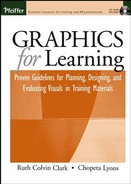One of our fundamental premises is that visuals that are effective for learning must promote psychological learning processes and avoid disrupting those processes. In this section we summarize the research that points to visuals that help learners convert lesson content into transferable knowledge and skills in memory. Chapters Four–Nine describe and illustrate visuals that help learners: focus attention to what's important, awaken prior knowledge in memory, avoid overloading working memory, build mental models in long-term memory, transfer new knowledge and skills to the job, and motivate learners to persist in achieving their learning goals.
Human learning is constrained by a unique architecture dominated by the properties of the two central memories: working memory and long-term memory. Working memory has a very limited capacity yet at the same time is the center of all conscious thought and learning. Therefore, the challenge is to optimize the limited capacity of working memory so it can be fully devoted to learning processes. In contrast, long-term memory has a large capacity but is inert. Therefore, when it's time to use new skills or knowledge back on the job, they must be retrieved out of long-term memory to be processed in working memory. This retrieval is the basis for transfer of learning from the instructional environment to the work setting.
Good instructional materials must accommodate this unique cognitive architecture by supporting one or more of the following learning processes:
Attending to important lesson content
Bringing prior knowledge relevant to the new skills from long-term memory into working memory
Reducing the load in working memory to utilize its limited capacity for learning processes
Helping learners build new mental models to be stored in long-term memory
Transfering new skills stored in long-term memory back into working memory when needed on the job
Motivating learners to initiate and complete learning goals
Successful instructional visuals support these processes while visuals that disrupt these processes impede learning. Our goal in this section is to describe each of these key processes and to illustrate how selection and design of visuals can affect each stage for better or for worse.
Our story would not be complete, however, without some mention of how individuals process visual content differently as a result of unique aptitudes and abilities. Therefore, Chapter Ten looks at how individual learning differences, especially prior knowledge and spatial ability, influence the processing of visuals.
Table I2.1. An Overview of Chapters Three-Ten.
Chapter | Topic | Summary |
|---|---|---|
3 | Learning Process Overview | Overviews the seven main processes that transform pictures and words in lessons into new mental models in human memory. |
4 | How to Direct Attention | Shows how to design graphics to help learners focus their attention to what is important and how to avoid divided attention that depresses learning. |
5 | How to Awaken Prior Knowledge | Shows how to position visuals early in a lesson to either activate relevant knowledge related to the lesson content or to build high-level knowledge to serve as a skeleton for the detailed content of the lesson. Emphasizes avoiding visuals that activate inappropriate prior knowledge. |
6 | How to Manage Memory Load | Shows how to design visuals and how to display words with visuals to maximize the limited capacity of working memory. |
7 | How to Build Mental Models | Shows how to use explanatory visuals to help learners build new mental models. |
8 | How to Support Transfer of New Skills | Distinguishes between the types of visuals appropriate to support transfer of procedural tasks and transfer of more conceptual tasks that rely on the worker's ability to adapt to changing situations. |
9 | How to Motivate Learners | Distinguishes between emotional and cognitive sources of motivation and describes ways to use visuals to support cognitive motivation. |
10 | How to Accommodate Individual Differences | Summarizes three individual differences that will affect how visuals can help learning and provides guidelines to design visuals that will be helpful for all learners. |
CHAPTER OUTLINE

Not All Visuals Are Equal
Graphics and Learning Processes
A Tale of Two Memories
Long-Term Memory Influences the Capacity of Working Memory
Visual and Auditory Components of WM
How Learning Happens
Drawing Attention to New Content
Awakening Appropriate Prior Knowledge
Managing Cognitive Load
Building Mental Models
Transferring New Skills After Learning
Optimizing Motivation
How Graphics Promote Learning
Leveraging the Benefits of Graphics: A Summary
